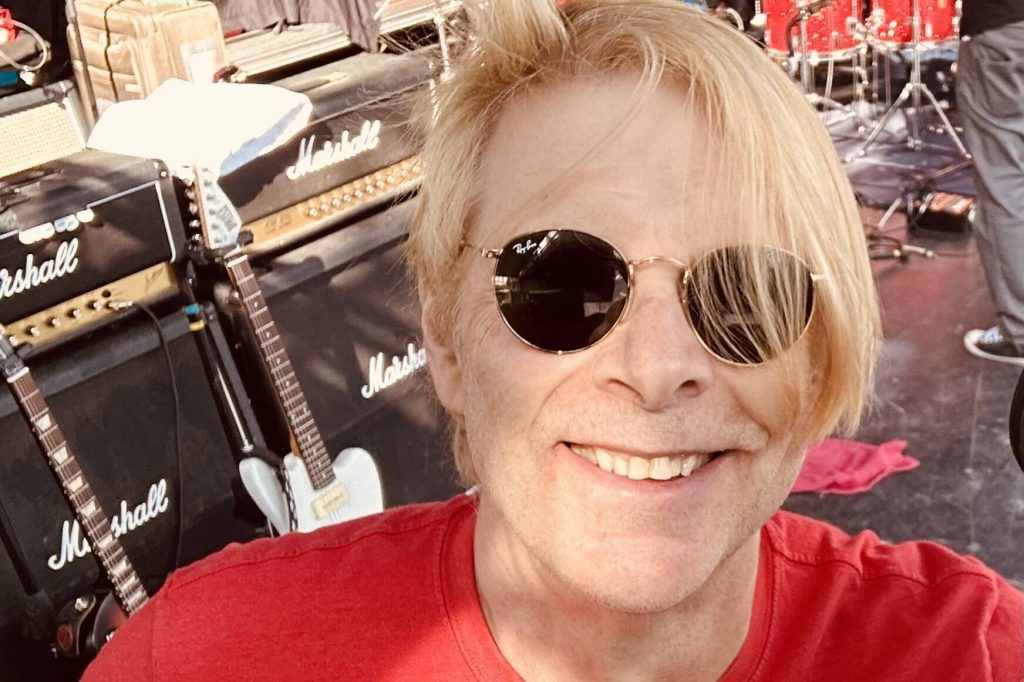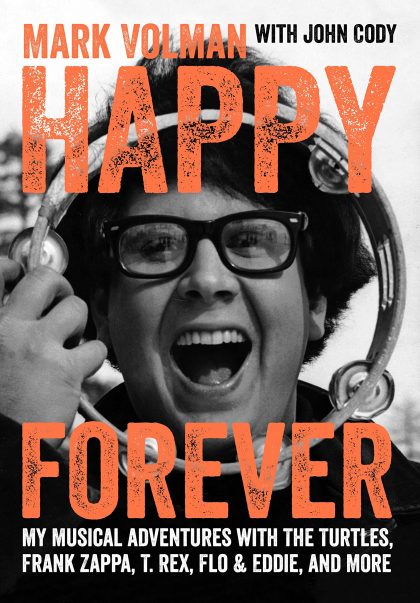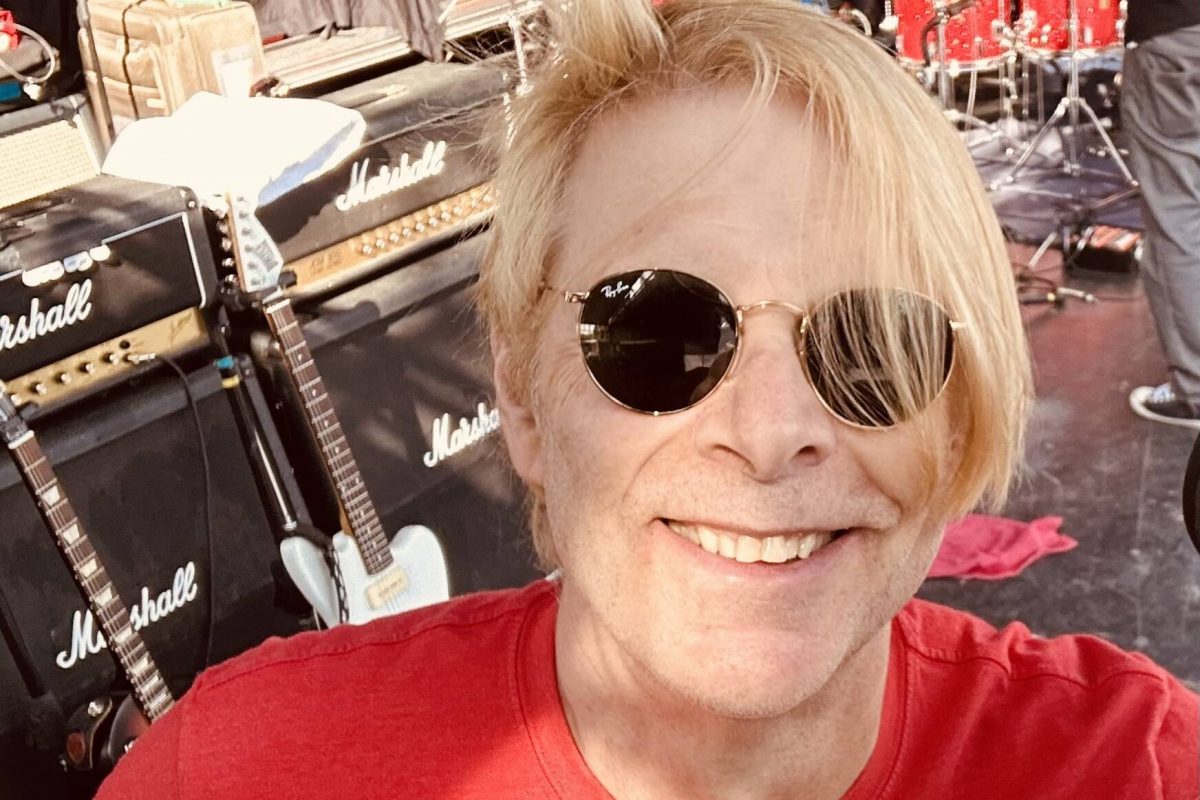
John Cody’s interviews at the heart of Mark Volman’s ‘Happy Forever’
by Alex Browne
December 14, 2023

Watching the old videos of the Turtles’ classic 1967 hit Happy Together on YouTube, the young Mark Volman’s presence is unmissable.
Not only does the ebullient, baby-faced, singer nail the high harmonies of the song with vocal partner Howard Kaylan – his irrepressible humour is evident throughout.
Already a little corpulent, and sporting an early version of his trademark tonsorial frizz, he bounces all over the stage, waving around a French horn that he barely pretends to play.
In another video performance of the song, his prop is a trumpet which he threatens to blow in Kaylan’s ear, prompting a clearly unrehearsed ‘quit goofing around’ look – and smile – from the other singer.
It’s that balance of musical dedication and joie-de-vivre that has always distinguished the California-born-and- raised Volman’s career as a pop and rock icon.
And it’s a continuing theme through his book Happy Forever, My Musical Adventures with the Turtles, Frank Zappa, T.Rex, Flo & Eddie, and More (Jawbone Press, 2023) co-authored by South Surrey musician, writer and record collector John Cody.
Far from a traditional memoir, it’s a word-portrait of Volman (the ‘Flo’ of Flo & Eddie) in the recollections of those who have known him through some six decades of performing – fellow musicians and collaborators, family members and other observers, interwoven with comments from Volman himself.
For those who experienced the music and the cultural changes of the last half of the 20th century – and for younger generations who have discovered their appeal since – the book is also virtually unparalleled as social history.
“It’s a kind of cross-section of the times,” Cody said of the book, which became an Amazon No. 1 seller in the U.S. shortly after its release in June.
“The whole target market is everybody – it isn’t specialized, or for people who just want to know about the records.”
In addition to Kaylan (a high school classmate and fellow choir member who was Volman’s consistent musical partner before retiring in 2018), contributors include Alice Cooper, Mickey Dolenz (of The Monkees), Ray Manzarek (of The Doors) Peter Noone (of Herman’s Hermits) Gail Zappa (widow of Frank Zappa) and many others whose names will be well-known by those with more extensive background knowledge of pop music in the 1960s, 1970s and 1980s.
Cody, who conducted, edited and compiled all of the interviews, was uniquely qualified for the task.
Long respected as a freelance rock and jazz drummer on the Vancouver scene, he’s married to Canadian rock legend Lee Aaron (a 2023 inductee into Canada’s Walk of Fame) and is a key member of her band.
“People did open up to me,” he agreed.
“It helped that I was able to avoid, generally, the gee-whiz, fanboy questions. The only person I was nervous about (talking to) was Mark Lindsay of Paul Revere and the Raiders – and that’s only because he was on the first record I ever bought. Fortunately, I didn’t flub it.”
Cody discovered long ago that the best interviews don’t start with a list of pre-conceived questions – they’re better when they’re more conversational.
“If it isn’t working, just ask everybody about their influences.”
Cody was asked to write the book by Volman, who had been interviewed by him another article about the period, and liked what he wrote.
“He told me: ‘you make me smarter than I am’,” Cody laughed.
Volman provided him with all the contacts he needed to get started, he added.
“It took more than a decade,” he said.
“It was a picking-it-up, putting-it-down project. Part of the issue was that Mark’s model was a book called George, Being George – a portrait of writer George Plimpton, in the words of those who knew him. Our book was essentially finished when a really good writer, John Einarson, pointed out a major flaw.
“His question was ‘Where’s Mark?’ And it was true –I was so focused on the model that I never thought to put Mark’s words in there. So we had to go back in and add Mark’s comments.”
The book tells Volman’s story to the present, including his surprising – and successful – return to academia in mid-life, which Cody attributes to some long-standing, but well-concealed, feelings of inferiority.
The process of conducting the interviews revealed that most who had encountered Volman have only warm and fuzzy memories of him, with only a few detractors and minor examples of lingering bitterness – which Cody noted must stand as something of a marvel in the emotion-charged, frequently contentious world of musical creatives.
“That wasn’t the case with Zappa, who was very challenging to work with and left some bitterness among band members who either felt they hadn’t been paid enough or received enough credit for their contributions,” he said.
“Pretty much everybody was positive. Everyone likes Mark – it’s significant that his two ex-wives have stayed friends with him and they and his two daughters are still very much involved in his life and taking care of him.”
A cancer survivor now in remission, Volman was also recently diagnosed with Lewy Body Dementia, the second most common form of progressive dementia after Alzheimer’s Disease. Characterized as affecting cognitive ability, sleep and behaviour – often accompanied by depression and anxiety – the condition has been recognized as a factor in the 2014 suicide of comedian Robin Williams.
But, miraculously, Volman appears to have bounced back from the diagnosis, Cody said, returning to touring this year after an initial interruption.
“Things are working so well that doctors are saying ‘this is who we should be studying’ to find out how other people can deal with it,” he said.
But time is marching on, of course, which did create a certain sense of urgency in finishing the book.
“I had a feeling that if I didn’t do it this history would be lost. I felt I needed to get on with the interviews because people were dying – in fact some of the people who contributed have since passed away.”
 The memories offered did result in one or two exclusives, and more than a few weird little-known facts, including that Volman and Kaylan – although their impeccable vocal credentials were already established – first auditioned for Zappa and the Mothers of Invention playing saxophones at Zappa’s request (both had played reeds in high school and in their early band The Crossfires).
The memories offered did result in one or two exclusives, and more than a few weird little-known facts, including that Volman and Kaylan – although their impeccable vocal credentials were already established – first auditioned for Zappa and the Mothers of Invention playing saxophones at Zappa’s request (both had played reeds in high school and in their early band The Crossfires).
“Somehow Frank knew this – I don’t know how,” Kaylan remembered. “Ian Underwood was already in the band…one of the greatest reed players I’ve ever heard. And we were honk-honk-honk-honk… After about three and a half minutes he said ‘Yeah, all right, put those down. I don’t think we’ll be needing those’.”
In another instance, Ray Manzarek recalled that Happy Together, with its “little bit of an old-fashioned, oompah beat” showed The Doors the right approach for a new song they were working on, the famous People Are Strange.
It became, he said, “like a minor, dark Happy Together.”
“And that was it. Like an actor always has to find some little thing that will help him get into character, we couldn’t get into the song until somebody said ‘Happy Together.’ And that’s what it was, man…I’ve never told anyone before.”
